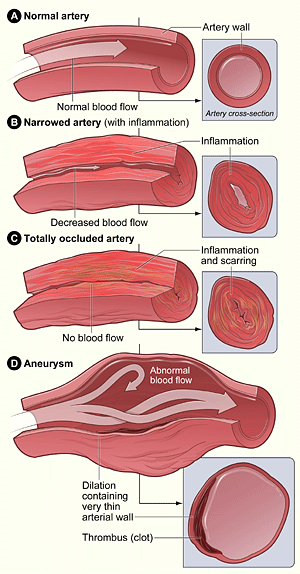What Is Vasculitis?
Vasculitis (vas-kyu-LI-tis) is a condition that
involves inflammation in the blood vessels. The condition occurs if your immune
system attacks your blood vessels by mistake. This may happen as the result of
an infection, a medicine, or another disease or condition.
The inflammation can lead to serious problems.
Complications depend on which blood vessels, organs, or other body systems are
affected.
Overview
Vasculitis can affect any of the body's blood
vessels. These include arteries, veins, and capillaries. Arteries carry blood
from your heart to your body's organs. Veins carry blood from your organs and
limbs back to your heart. Capillaries connect the small arteries and veins.
When a blood vessel is inflamed, it can narrow or
close off. This limits or prevents blood from getting through the vessel.
Rarely, the blood vessel will stretch and weaken, causing it to bulge. This
bulge is known as an
aneurysm
(AN-u-rism).
Vasculitis

Figure A shows a normal artery with
normal blood flow. The inset image shows a cross-section of the normal artery.
Figure B shows an inflamed, narrowed artery with decreased blood flow. The
inset image shows a cross-section of the inflamed artery. Figure C shows an
inflamed, blocked (occluded) artery and scarring on the artery wall. The inset
image shows a cross-section of the blocked artery. Figure D shows an artery
with an aneurysm. The inset image shows a cross-section of the artery with an
aneurysm.
The disruption in blood flow from inflammation can
damage the body's organs. Signs and symptoms depend on which organs have been
damaged and the extent of the damage.
Typical symptoms of inflammation, such as fever and
general aches and pains, are common among people who have vasculitis.
Outlook
There are many types of vasculitis, but overall the
condition is rare. If you have vasculitis, the outlook depends on:
- The type of vasculitis you have
- Which organs are affected
- How quickly the condition worsens
- How severe the condition is
Treatment often works well if the condition is
diagnosed and treated early. In some cases, vasculitis may go into remission.
"Remission" means the condition isn't active, but it can come back, or "flare,"
at any time.
Some cases of vasculitis are chronic (ongoing) and
never go into remission. Long-term treatment with medicines often can control
the signs and symptoms of chronic vasculitis.
Rarely, vasculitis doesn't respond well to
treatment. This can lead to disability and even death.
Much is still unknown about vasculitis. However,
researchers continue to learn more about the condition and its various types,
causes, and treatments.
March 2009 |

